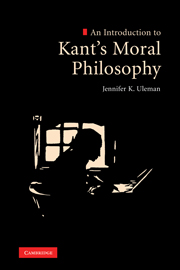Book contents
- Frontmatter
- Contents
- Acknowledgements
- 1 Introduction: the strange thing
- 2 A sketch of Kantian will: desire and the human subject
- 3 A sketch continued: the structure of practical reason
- 4 A sketch completed: freedom
- 5 Against nature: Kant's argumentative strategy
- 6 The categorical imperative: free will willing itself
- 7 What's so good about the good Kantian will? The appeals of the strange thing
- 8 Conclusion: Kant and the goodness of the good will
- Bibliography
- Index
3 - A sketch continued: the structure of practical reason
Published online by Cambridge University Press: 05 June 2012
- Frontmatter
- Contents
- Acknowledgements
- 1 Introduction: the strange thing
- 2 A sketch of Kantian will: desire and the human subject
- 3 A sketch continued: the structure of practical reason
- 4 A sketch completed: freedom
- 5 Against nature: Kant's argumentative strategy
- 6 The categorical imperative: free will willing itself
- 7 What's so good about the good Kantian will? The appeals of the strange thing
- 8 Conclusion: Kant and the goodness of the good will
- Bibliography
- Index
Summary
In this second stage of a three-stage effort to sketch the Kantian will, we turn to the structure of practical rationality, that is, to the structure of the will insofar as will is, for Kant, reason in its practical employment. This stage of the effort will take us through the architecture of Kantian practical reason. We will look at the kinds of representations and propositions, and at the kinds of possible relations between them that, taken together, constitute practical reason's basic structure and internal logic.
WILL AS PRACTICAL REASON: PRACTICAL RULES, LAWS, AND PRINCIPLES
A first thing to do is to clarify the many terms that figure in Kant's descriptions of practice, or action. Practice (or action), properly speaking, consists for Kant in movement according to rules we represent to ourselves – we saw this in Chapter 2. But what does Kant mean by ‘rule’? ‘Rule’ is, for Kant, a fairly all-purpose term. Rules, or, in German, Regeln, either describe or prescribe regularities. Plants grow toward the sun; the first word of a sentence is capitalized; parking after 6 p.m. is by permit only. Each of these is a kind of rule. Now rules, as both we and Kant use the term, can admit of exceptions. Fungi, though plants, spurn sunlight; sentences in many non-Latin alphabets, in some other character sets, and in many people's emails, do not begin with capitalized letters; parking regulations may be suspended during special events. We might say that rules can apply contingently or locally.
Information
- Type
- Chapter
- Information
- An Introduction to Kant's Moral Philosophy , pp. 39 - 62Publisher: Cambridge University PressPrint publication year: 2010
